NH-L9a-AM5 and NH-L9a-AM5 chromax.black
My ties with SFF builds go way back and Noctua’s NH-L9 coolers have played a big part in a lot of those builds over the years. The NH-L9 coolers are unique from Noctua in that they are socket specific whereas all of their other coolers have supported any socket including Noctua providing brackets for coolers as time has gone on. Well with the new AM5 socket, Noctua updated their design once again with both the NH-L9a-AM5 and the NH-L9a-AM5 chromax.black and they sent both over to check out. The NH-L9a-AM5 is of course updated for the new socket and the chromax.black model is the same but blacked out in true chromax fashion. The chromax lineup hit the L9 lineup back in 2019, relatively late into the lineup so a majority of the L9 coolers I have used in the past have been the traditional Noctua style but I have even gone as far as designing my own fan cover to help get the colors to match builds when needed.
The NH-L9a-AM5 and NH-L9a-AM5 chromax.black both have the same sized box but like with other Noctua coolers they have different styling. The chromax cooler has a blacked-out box with just the Noctua brown on the edges and a picture of the cooler across the front. The standard NH-L9a-AM5 on the other hand has the traditional Noctua packaging including the zoomed-in picture of the cooler giving it that brown background. The chromax has another picture on the back along with a few key features highlighted. Then both have the specifications on the side of the box which is helpful.




When you open the boxes up they both have the cooler featured in the middle sitting in a pull-up surround. The chromax has an angular black design whereas the standard NH-L9a-AM5 has black with a brown accent. Then when you pull up on that it pulls the cooler out and under it, they both have a tube with the accessories inside. The chromax is black whereas the standard model is brown. You also get a folded-up instruction manual which has line drawings guiding you through the installation. Because this cooler is specific to AM5, only one instruction is needed. This also has a thank you for your purchase and the signature from Roland Mossig, Noctua’s CEO.



Both tubes come with nearly the same accessories with one exception. The NH-L9a-AM5 chromax.black has black screws for all of its screws whereas the standard NH-L9a-AM5 has chromed screws for the fan screws. You get that pack of mounting and fan screws, a low power adapter that can be plugged inline for the fan to lower the fan speed, an Allen wrench, a full tube of thermal paste, and a case badge. Noctua’s case badge is a thick metal design that has been painted, I know that case badges aren’t important to most people anymore but I love the quality of their design and wish more were like it. The same goes for them including a full tube of thermal paste which adds a lot of value to the cooler compared to the competition. Especially given that this isn’t cheap thermal paste, it is the same stuff I use on everything.

Both of the NH-L9a-AM5 coolers have the same overall design. This is 114 mm wide, 92 mm deep, and then 23 mm tall without the included fan and 37 mm with the fan included. It is 390 grams without the fan and 465 grams with it. Their aluminum cooling fin design uses a copper base and heatpipes to pull the heat out across the cooler and has nickel plating and soldered joints. Really the overall design isn’t any different from the NH-L9Aa-AM5 or the original NH-L9A which supported AM3 CPUs. This design is different from what Noctua uses for their Intel design, the AMD coolers have a longer length. The fan comes preinstalled on top which blows down into the cooler. Noctua uses the NF-A9x14 HS-PWM for the standard cooler and the Noctua NF-A9x14 HS-PWM chromax.black for the chromax model. Both have an SSO2 bearing which helps get the MTTF up over > 150.000 h. They can run up to 2500 RPM or 1800 RPM when using the L.N.A. adapter that is included. They can also run down to 600 RPM for their lowest speed.



Noctua is able to get the overall height so low because they use the specific CPU brackets, not their universal design which has a bracket that then attaches to another bracket on the cooler. You can really see this when looking at both from the side profile. The bracket is just below the heatsink and the fan is nearly as thick as the cooler as well. Both ends of the cooler have holes for the heatpipes but they only stick out on one end. The heatpipe design is U shaped with two in total. They sit over the CPU then run to the end where they don’t stick out and turn around and run near the outside and out the other end. You can see them slightly in the pictures later looking from the bottom. The extra length of the cooler does extend past the size of the fans and the fan brackets start on the ends and have the Noctua branding on them and wrap around the top tightly. The standard model has the nickel-plated finish for the heatsink whereas the chromax model has it all blacked out including the fins themselves which Noctua is careful to make sure it is all black brackets and all.





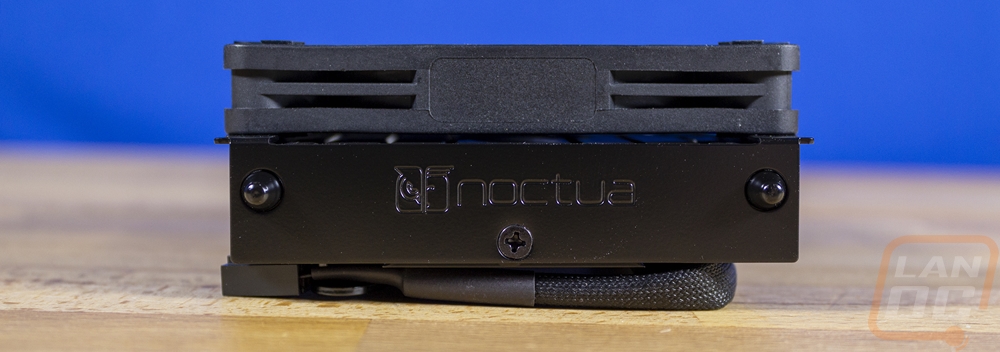

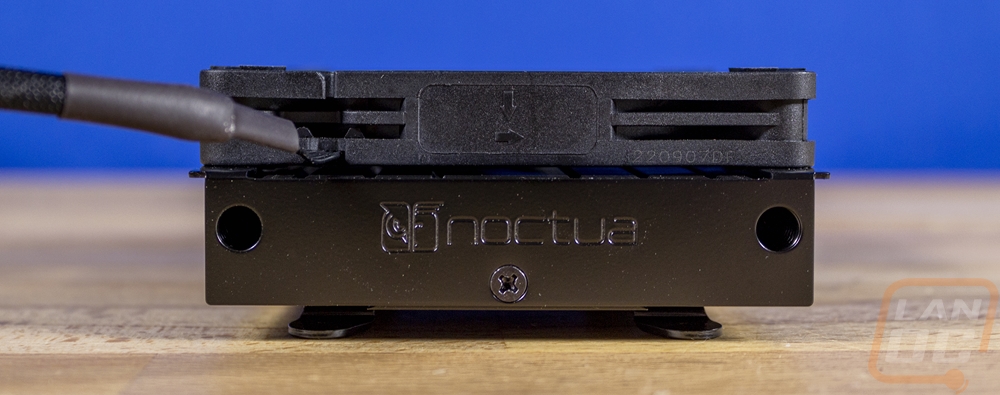
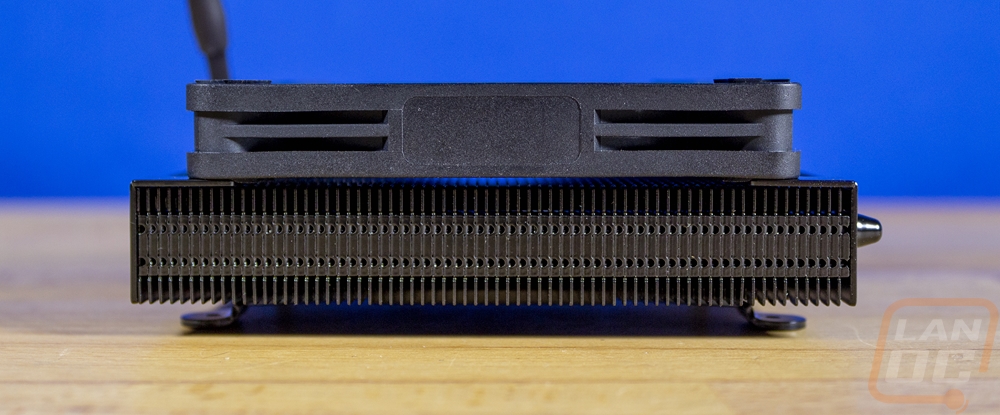

The bottom view gives us a peak at the heatpipes through the heatsink itself. But it’s really interesting to see the bracket design with how flat and compact it is. They are screwed on and can be changed out. Noctua has offered upgrades for these with new sockets as well which can be comforting if you are worried about being locked into one socket. That said at this point AM5 is still very new and we know it will be around for a while. The chromax model is blacked out across the brackets with just the CPU contact surface being the only area that isn’t blacked out. The finish, like with other Noctua coolers, isn’t a full mirror finish as you can see the machined circle design in it but it does still have a good reflection when you put things up against it.


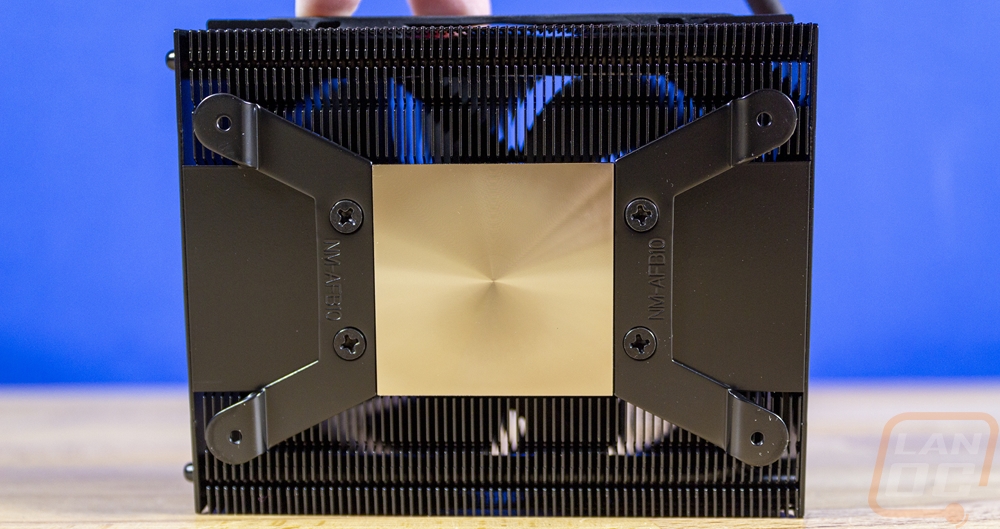

Comparison shot between the NH-L9a-AM5 and the NH-L9a-AM5 chromax.black. While the standard Noctua design has grown on me over the years, I do really dig the lengths they will go to make sure the entire cooler is blacked out and that is going to look better with most builds.
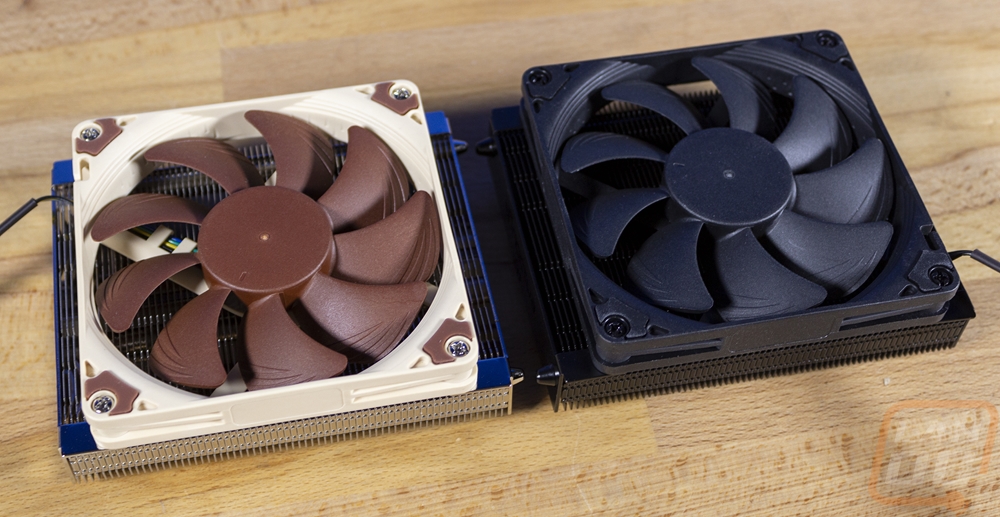
Installation of both of the NH-L9a-AM5 coolers is exactly the same. The new AM5 design is a little different than in the past, however. Part of keeping it so compact, they drop the bracket you install on the motherboard altogether and you just put your thermal paste on the CPU and run screws from the bottom. In the past, you would remove the AMD brackets and backplate and use the included backplate replacement but with AM5 you can’t remove the backplate anymore. The four screws that hold the plastic clip holders have to be removed. But there are still four screws that hold the new LGA bracket which screws into the backplate as well. So the normal thick Phillips screws that past NH-L9a coolers used wouldn’t work this time around. The new screws are thinner and have an Allen head. This is because they slide in through the screw holes in the bracket for the stock tie down.


Now I’m testing the NH-L9a-AM5 on a full-sized board which makes it look even smaller. But the design is great in that you don’t have to worry at all about memory fitment or anything else because it fits over the CPU socket area and nothing else. It is as short as memory without heatspreaders so height isn’t an issue as well. So when used with an ITX motherboard you make a compact design with the cooler and ram no higher than the rear I/O height.


The NH-L9a-AM5 isn’t designed to work with the higher-end 125-watt or even 170-watt CPUs but Noctua does have a comprehensive breakdown of CPU compatibility for the two coolers. I didn’t want to go through each and every model but I did get out the Ryzen 5 7600 and the Ryzen 7 7700 which are both 65-watt CPUs to get a look at the cooler's performance. There wasn’t any point in testing both so I went with the base NH-L9a-AM5. For testing, I tested using the AIDA64 Stress Test with the CPU workload and again with the FPU workload. In my experience, the CPU workload is more like what you will see when gaming and other normal activities and the FPU is more like rendering and other heavy workloads. I did document both temperatures as well as clock speeds because cooling makes a big difference in overall clock speeds on these CPUs especially. The NH-L9a-AM5 handled both CPUs with the CPU workload but you can see how the FPU workload put a strain on things. I did also test with the stock fan profile and at 100% fan speed but that didn’t make any difference with the 7700 and the difference was small on the 7600 as they are both still pushing the NH-L9a-AM5 close to its limits. The 7700 has a boost clock of p to 5.3 GHz and the 7600 is 5.1 GHz so you can see in the clock speeds that both don’t reach their maximum potential in the tests but the 7600 does get close when it comes to the CPU workload.
|
Fan Speed |
CPU Diode Temperature |
Clock Speed |
|
Ryzen 5 7600 CPU Workload |
||
|
Stock Fan Profile |
84c |
4975 MHz |
|
100% Fan Speed |
79c |
5000 MHz |
|
Ryzen 5 7600 FPU Workload |
||
|
Stock Fan Profile |
95c |
4398 MHz |
|
100% Fan Speed |
95c |
4425 MHz |
|
Ryzen 5 7700 CPU Workload |
||
|
Stock Fan Profile |
85c |
5073 MHz |
|
100% Fan Speed |
84c |
5073 MHz |
|
Ryzen 5 7700 FPU Workload |
||
|
Stock Fan Profile |
88c |
4173 MHz |
|
100% Fan Speed |
87c |
4173 MHz |
When testing I also took a look at noise levels and documented them. I tested at 50% and 100% fan speeds themselves then also tested what the noise levels were when using the AIDA64 CPU workload after a half hour. The NH-L9a-AM5 isn’t loud even with the fans cranked up, which is good because when run under constant load with the AM5 CPUs it does push the coolers limits and has it running close to 100% fan speed for the 7600 and at 100% fan speed for the 7700 as you can see.
|
Fan Speed |
Decibels |
|
50% Fan Speed |
34.4 dB |
|
100% Fan Speed |
41.5 dB |
|
Under Load w/Ryzen 7600 |
40.2 dB |
|
Under Load w/Ryzen 7700 |
41.6 dB |


